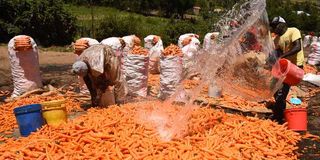Premium
Where to get yellow, purple, white carrot seeds

Carrots being cleaned in Mau Narok in preparation for sale.
Hi, crop expert. Apart from the ordinary orange carrot grown in Kenya, is there another variety? I’m a farmer who loves doing what others have never attempted. Where can I get the seeds and what do I need to do in order to get good harvests?
Peter Githaiga, Nyandarua.
Apart from the orange carrots grown in Kenya, we also have purple, red, white and yellow carrots. The seeds of these carrots can only be imported.
For yellow carrot seeds, contact Vintage Seed Company on [email protected].
For purple and white carrot seeds, get in touch with [email protected].
For purple and red carrots, try [email protected] or call +254 20 3892530.
Carrots do well in areas with altitude greater than 500 metres above sea level.
They require deep, loose, loamy soils that are well drained. Poor drainage encourages bacterial diseases in carrots.
If carrots are grown in heavy clay soils, the resulting carrots are twisted, malformed and of low quality.
The optimum soil pH is 6 to 6.5. There will be no harvest at pH of less than 5.2. Carrots are cool season crops but can withstand warm conditions to some extent.
High soil temperatures will lead to short roots and influence germination. Germination best occurs at 25 to 30 degrees Celsius, while vigorous growth and good colour development is best at 15 to 20 degrees.
Temperatures greater than 25 degrees Celsius results in pale colour of the carrots. The resulting carrots have a strong flavour and are coarse.
Too low temperatures induce bolting or premature flowering. Carrots can tolerate a wide range of rainfall but excessive rain may cause a reduction in root colour.
Lack of water causes cracking and branching of roots – as they search for water.
Carrots are grown from seeds directly on well prepared beds.
Seeds are sown in drills 30 to 40 centimetres apart, then thinned when five to eight centimetres high to five to eight centimetres apart, depending on the vigour of the cultivar. Thinning improves root size but reduces harvest/unit area.
Carrots grown for seed production are drilled more densely so as to produce uniform seedlings that are vernalised for two to eight weeks so as to bolt and produce flowers.
Seedlings may be earthed up when roots begin to enlarge in order to protect them from high soil temperature and greening.
If the soil temperature is high, root development and expansion is inhibited. The seed rate is 450g/ha.
A good supply of nitrogen, phosphorous and potassium is required for good growth.
Potassium is applied by topdressing when plants are well established. Carrots have a high demand for potassium. Application of fresh manure to carrots leads to branching or forking, which lowers quality.
Where manure is to benefit carrots, it should be applied to the preceding crop. Alternatively, manure should be well-rotten or leached.
Micro-nutrient deficiencies in the soil should be rectified, particularly those of manganese and boron. Lack of boron causes splitting of the roots.
Irrigation is required during the dry season to prevent a check in root development or root branching.
Hand weeding is widely used. It should be shallow to minimise damage to roots.
Pre-emergence herbicides may be applied for large-scale production. Thorough seedbed preparation may help check weeds.
Roots are ready for harvesting when having a diameter of two centimetres or larger at the upper end. This is usually 70 to 85 days from planting.
Irrigation prior to lifting reduces damage to the roots. Yields are 8-15 tonnes per hectare. Harvested roots may be sold bunched (with tops) or debunched/bulk (tops removed).
Most carrots for market are now topped (tops removed), which greatly reduces water loss from roots and increases storage life.
However, many fresh market buyers prefer green tops left on the roots since this presents a more attractive product.
Debunched carrots are usually bagged so as to reduce weight loss during transport and storage. Carrots store best at zero degrees Centigrade and relative humidity of 93 to 98 per cent.
At higher temperatures – greater than four degrees Celsius – carrots may sprout, develop bitter taste, lose sugar or may be attacked by pathogens.
Several insect pests can attack carrots. The carrot fly adult lays eggs in cracks next to the roots. When larvae hatch, they bore into roots, rendering them unmarketable. The larvae are yellowish white. Use of insecticides such as Parathion and Aldrin to control them.
Other pests are cut worms and nematodes.
Leaf blight (Alternaria dauci) and Cercospora diseases cause dead spots on leaves in the wet season.
Symptoms are more severe on older leaves on the maturing crop, giving a scorched appearance.
The diseases are seed-borne. They are controlled by soaking seeds in Thiram and spraying with fungicides.
Carrot/Aster Yellows is a mycoplasma disease spread by the six-spotted leafhopper.
Infected plants have a pale yellow cast and a heavy concentration of very fine rootlets on the taproot. The carrot farmer needs to control the vector.
Carol Mutua
Crop Production Specialist




